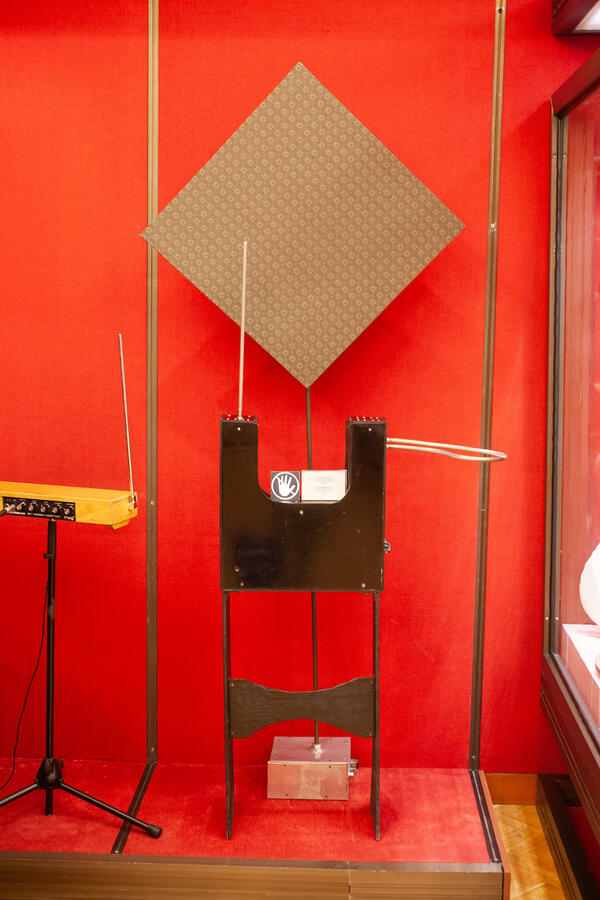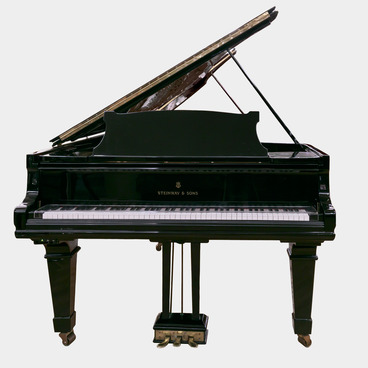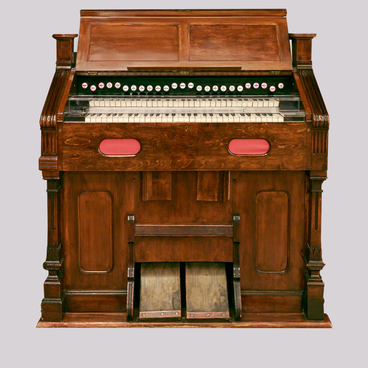The world’s first electronic musical instrument was named the etherphone and later the theremin. It was created by the Russian inventor, physicist, and cellist Leon Theremin in Petrograd (Saint Petersburg) between 1917 and 1919. In 1920, he first demonstrated the new instrument at a scientific meeting.
The sound is produced by two radio frequency oscillators beating together. The instrument is unique because it is controlled without any physical contact from the performer. The player creates a melody by moving their hands in the proximity of two metal antennas. The pitch is determined by moving the right hand in front of a vertical antenna, while the volume is controlled by moving the left hand above the loop antenna.
The early models had a single pitch oscillator and a range of over seven octaves. Their tone resembled the human voice, violin, or cello. The instrument was sometimes called the “ether violin.”
In March 1922, Leon Theremin visited the Kremlin. After performing the arrangements of some famous compositions on the theremin, he started teaching Vladimir Lenin to play the instrument. The inventor also demonstrated his security alarm based on a capacitance relay.
In 1927, Leon Theremin gave concerts in Germany, France, the UK, and the USA, and patented the theremin as a “musical instrument with vacuum tubes.” By the early 1930s, he organized a theremin school in the United States and concluded contracts for commercial production of the theremin. Around 3,000 theremins were made.
The theremin has been widely used by both solo performers and ensembles. It can be heard in early sound movies “Aelita, ” and “The Komsomol — Sponsor of Electrification.” In the 1960s, Leon Theremin made two classical theremins — one for the Polytechnic Museum, and the other for the Museum of Music.
In 1975, Leon Theremin presented a polyphonic theremin in the Soviet Union. Between the 1970s and the 1990s, the instrument experienced a new surge of popularity. The Museum of Music hosted concerts of musicians performing with modern theremins, including Leon Theremin’s student and relative Lydia Kavina, his great-grandson Pyotr Termen, and the composer Olesya Rostovskaya.
The sound is produced by two radio frequency oscillators beating together. The instrument is unique because it is controlled without any physical contact from the performer. The player creates a melody by moving their hands in the proximity of two metal antennas. The pitch is determined by moving the right hand in front of a vertical antenna, while the volume is controlled by moving the left hand above the loop antenna.
The early models had a single pitch oscillator and a range of over seven octaves. Their tone resembled the human voice, violin, or cello. The instrument was sometimes called the “ether violin.”
In March 1922, Leon Theremin visited the Kremlin. After performing the arrangements of some famous compositions on the theremin, he started teaching Vladimir Lenin to play the instrument. The inventor also demonstrated his security alarm based on a capacitance relay.
In 1927, Leon Theremin gave concerts in Germany, France, the UK, and the USA, and patented the theremin as a “musical instrument with vacuum tubes.” By the early 1930s, he organized a theremin school in the United States and concluded contracts for commercial production of the theremin. Around 3,000 theremins were made.
The theremin has been widely used by both solo performers and ensembles. It can be heard in early sound movies “Aelita, ” and “The Komsomol — Sponsor of Electrification.” In the 1960s, Leon Theremin made two classical theremins — one for the Polytechnic Museum, and the other for the Museum of Music.
In 1975, Leon Theremin presented a polyphonic theremin in the Soviet Union. Between the 1970s and the 1990s, the instrument experienced a new surge of popularity. The Museum of Music hosted concerts of musicians performing with modern theremins, including Leon Theremin’s student and relative Lydia Kavina, his great-grandson Pyotr Termen, and the composer Olesya Rostovskaya.



